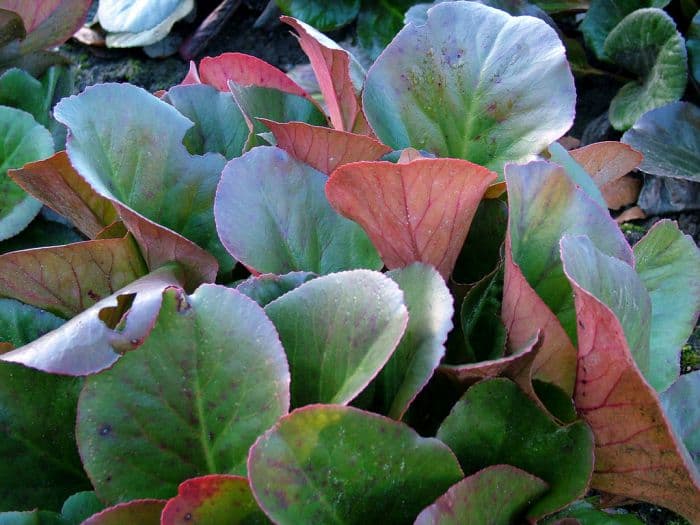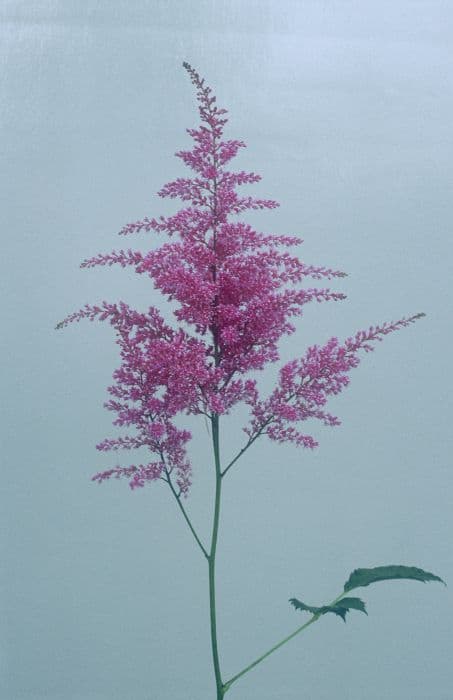Elephant's Ears Bergenia 'Sunningdale'

ABOUT
Bergenia 'Sunningdale' is a perennial plant known for its lush, rounded to heart-shaped leaves that have a leathery texture. These leaves often turn reddish-bronze during colder months, providing year-round interest. The foliage emerges from a central rhizome, creating a clumping habit that showcases its glossy leaves. In spring, 'Sunningdale' sends up sturdy, fleshy stems above the foliage, which are adorned with panicles of bell-shaped flowers. The blooms are usually in a range of pinks, ranging from soft pastel shades to more intense hues, depending on the specific variety and environmental factors. These attractive blossoms can add a touch of charm and color to the garden during the blooming season. The overall appearance of Bergenia 'Sunningdale' is one of robustness and decorative appeal with its evergreen leaves and seasonal floral display.
About this plant
 Names
NamesFamily
Saxifragaceae.
Synonyms
Elephant's Ears, Pigsqueak, Leather Bergenia, Heartleaf Bergenia, Megasea.
Common names
Bergenia 'Sunningdale'
 Toxicity
ToxicityTo humans
Bergenia, often known as elephant's ears, does not have a significant reputation for being toxic to humans. There is limited information available about the plant causing severe poisoning in humans. However, as with any plant material, individual reactions can vary, and it is possible for some people to experience mild gastrointestinal upset if any part of the plant is ingested. If you suspect ingestion and experience symptoms such as nausea, vomiting, or diarrhea, it is advisable to consult with a medical professional.
To pets
Elephant's ears may not be highly toxic to pets, but ingestion could still potentially lead to mild gastrointestinal upset in animals such as dogs or cats. Symptoms of poisoning could include vomiting, diarrhea, and drooling. If a pet consumes part of the elephant's ears plant and exhibits these symptoms, contacting a veterinarian would be recommended to ensure their well-being and receive advice on any needed treatment.
 Characteristics
CharacteristicsLife cycle
Perennials
Foliage type
Evergreen
Color of leaves
Green
Flower color
Pink
Height
1 foot (30 centimeters)
Spread
2 feet (60 centimeters)
Plant type
Herb
Hardiness zones
4
Native area
Asia
Benefits
 General Benefits
General Benefits- Attractive foliage: Bergenia 'Sunningdale' has large, glossy leaves that turn bronze to red in the fall, providing interest throughout multiple seasons.
- Drought tolerance: Once established, this plant is fairly tolerant of dry spells, reducing the need for frequent watering.
- Low maintenance: It requires minimal care once established, making it suitable for gardeners of all skill levels.
- Shade tolerance: It can thrive in partial shade, which makes it versatile for planting in different garden aspects.
- Winter interest: The leaves of Bergenia 'Sunningdale' often persist through mild winters, providing color and texture when many other plants are dormant.
- Rabbit and deer resistance: It's generally resistant to browsing by deer and rabbits, which can protect it from wildlife damage.
- Erosion control: Its dense, clumping habit can help prevent soil erosion on slopes and in other vulnerable areas of the garden.
- Ground cover: Its spreadable form makes it an excellent ground cover, capable of suppressing weeds once it has fully established.
 Medical Properties
Medical PropertiesThis plant is not used for medical purposes.
 Air-purifying Qualities
Air-purifying QualitiesThis plant is not specifically known for air purifying qualities.
 Other Uses
Other Uses- Bee attractant: The Bergenia 'Sunningdale' can be planted to attract bees, as its blooms are rich in nectar and pollen, supporting local pollinator populations.
- Ground cover: Due to its dense foliage, it can be used as a ground cover to help suppress weeds and reduce soil erosion in garden beds.
- Ornamental borders: Its attractive foliage and flowers make it suitable for creating visual borders in ornamental gardens.
- Rock gardens: Bergenia 'Sunningdale' can be used in rock gardens, complimenting the rugged aesthetic with its robust nature and attractive foliage.
- Container gardening: It's well-suited for container gardening, providing year-round interest with its evergreen leaves and spring flowers.
- Flower pressing: The flowers of Bergenia can be used for crafts such as flower pressing due to their distinct shape and color.
- Seasonal interest: It can provide seasonal interest in winter gardens with its persistent leaves that often change color in colder weather.
- Photography subject: With its attractive blooms and leaves, it is an appealing subject for garden photographers.
- Erosion control on slopes: Its root system helps stabilize soil on slopes, preventing erosion.
- Fabric dyeing: Historically, some species of Bergenia were used for dyeing fabric, although this is less common now.
Interesting Facts
 Feng Shui
Feng ShuiThe Bergenia is not used in Feng Shui practice.
 Zodiac Sign Compitability
Zodiac Sign CompitabilityThe Bergenia is not used in astrology practice.
 Plant Symbolism
Plant Symbolism- Endurance: Bergenias are known for their hardiness and ability to survive harsh conditions, symbolizing a person's endurance through challenging times.
- Tenacity: As a plant that grips firmly to the ground and is tough to uproot, bergenia represents tenacity and holding one’s ground.
- Adaptability: This plant can thrive in a variety of environments, making it a symbol of adaptability and flexibility in life.
- Protection: The large leaves of bergenia are often seen as offering a protective "umbrella," representing the concept of shelter and care.
 Water
WaterElephant's Ears plants like the Bergenia 'Sunningdale' should be watered thoroughly when the top inch of soil feels dry to the touch. Generally, this means watering about once a week, but the frequency may vary depending on environmental conditions such as temperature and humidity. Each watering session should involve slowly pouring water at the base of the plant until it begins to run out from the bottom of the pot, indicating that the soil is fully saturated. Aim to provide the plant with about one gallon of water every two weeks during the growing season, while reducing the amount slightly in the winter when the plant's growth slows down.
 Light
LightElephant's Ears plants need bright, indirect light to thrive. Bergenia 'Sunningdale' should be placed in a spot where it receives filtered sunlight, avoiding direct harsh rays that could scorch the foliage. An ideal position would be near an east-facing or north-facing window where it can take advantage of the soft morning light or diffused sunlight throughout the day.
 Temperature
TemperatureElephant's Ears plants prefer moderate temperatures and can be quite hardy. The Bergenia 'Sunningdale' can typically survive in temperatures ranging from 40 to 85 degrees Fahrenheit. These plants do best in a temperature range of 60 to 75 degrees Fahrenheit. Protect them from extreme cold, and avoid exposure to temperatures below the minimum range, as frost can damage the foliage.
 Pruning
PruningPruning helps to keep Elephant's Ears plants like the Bergenia 'Sunningdale' healthy and aesthetically pleasing. It's best to prune in the spring, removing any dead or damaged leaves to encourage new growth. Additionally, after flowering, remove spent flower stalks to tidy up the plant. Prune every few years to maintain a compact shape and prevent the plant from becoming too leggy.
 Cleaning
CleaningAs needed
 Soil
SoilElephant's ears thrive in moist, well-draining soil with a pH ranging from slightly acidic to neutral; a good mix can be made from loamy garden soil, peat, and perlite in equal parts.
 Repotting
RepottingElephant's ears should be repotted every two to three years or when the clumps become overcrowded, generally in spring before new growth starts.
 Humidity & Misting
Humidity & MistingElephant's ears prefer high humidity but are quite adaptable and can tolerate average room humidity levels.
 Suitable locations
Suitable locationsIndoor
Place in bright, indirect light and water when topsoil feels dry.
Outdoor
Plant in partial shade, shield from harsh sun, keep soil moist.
Hardiness zone
3-8 USDA
 Life cycle
Life cycleBergenia 'Sunningdale', commonly known as Sunningdale Bergenia, begins its life cycle when a seed germinates in late spring to early summer, given appropriate moist and cool conditions. The seedling then develops into a young plant with characteristic large, rounded leaves. As the plant matures, it forms a clump with a thick rhizome at its base, and the evergreen leaves grow into a rosette shape, remaining throughout the year. In early to mid-spring, it sends up flowering stalks with clusters of pink to red flowers which are attractive to pollinators. After blooming, the plant sets seed, which can be dispersed to start new plants, while the parent plant's foliage may die back partially in colder winter climates but generally persists due to its evergreen nature. As a perennial, Bergenia 'Sunningdale' enters a period of dormancy over winter and resumes active growth with the return of warmer temperatures in spring.
 Propogation
PropogationPropogation time
Spring to Summer
The most popular method of propagating Bergenia 'Sunningdale', commonly known as Elephant's Ears, is by division. This process is best undertaken in late autumn or early spring. To propagate by division, carefully dig up an established clump of Elephant's Ears and gently separate the plant into smaller sections, each with a portion of the root system intact. Make sure that each division has at least one growth point or bud. These divided sections can then be replanted at the same depth they were originally growing, spaced about 12 to 15 inches (approximately 30 to 38 centimeters) apart to allow ample room for growth. Water the new plants thoroughly after replanting to help establish them. Division not only helps to propagate new plants but also rejuvenates older clumps that may have become woody or less vigorous.









